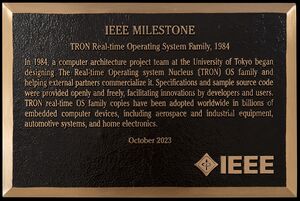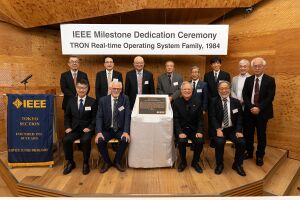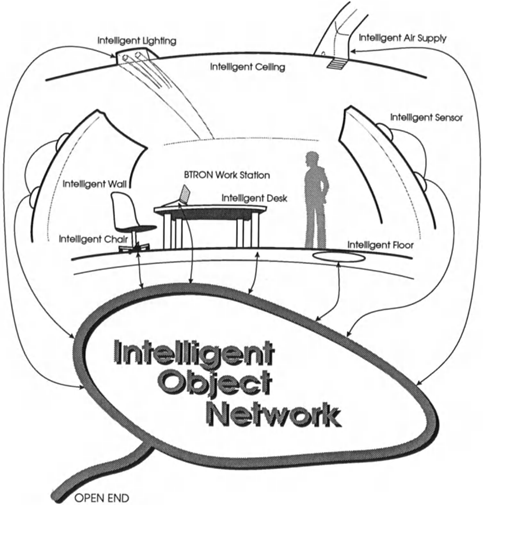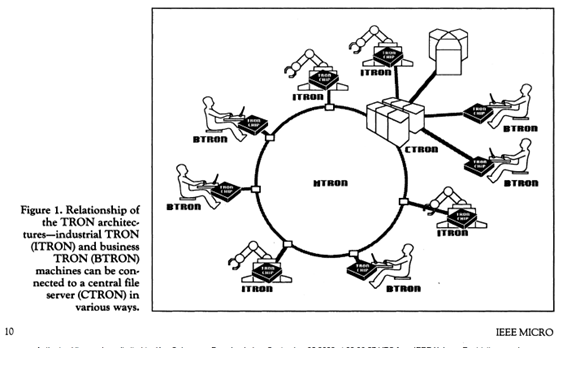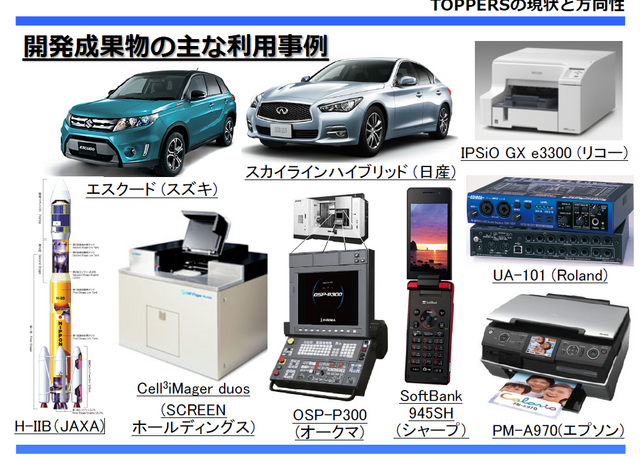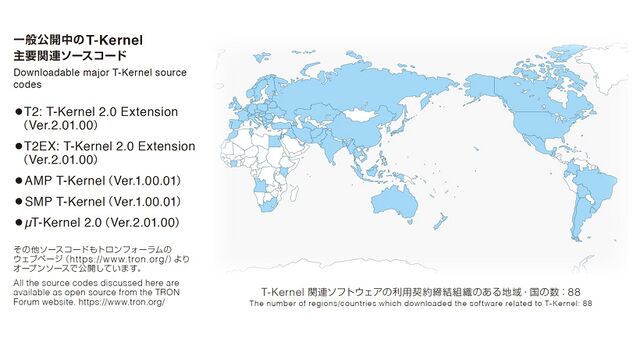Milestones:TRON Real-time Operating System Family, 1984
Title
TRON Real-time Operating System Family, 1984
Citation
In 1984, a computer architecture project team at the University of Tokyo began designing The Real-time Operating system Nucleus (TRON) OS family and helping external partners commercialize it. Specifications and sample source code were provided openly and freely, facilitating innovations by developers and users. TRON real-time OS family copies have been adopted worldwide in billions of embedded computer devices, including aerospace and industrial equipment, automotive systems, and home electronics.
Street address(es) and GPS coordinates of the Milestone Plaque Sites
- Site 1: The University of Tokyo, The Daiwa Ubiquitous Computing Research Building: 7-3-1 Hongo, Bunkyo-ku, Tokyo 113-0033 Japan (35.7079711, 139.7626922)
- Site 2: Toyo University, Graduate School of Information Networking for Innovation and Design, 1-7-11 Akabanedai, Kita-ku, Tokyo 115-8650 Japan (35.7802941, 139.7129714)
Details of the physical location of the plaque
Site 1 and Site 2: On a wall in the entrance hall next to the IEEE Milestone plaque for The Pioneering TRON Intelligent House
How the plaque site is protected/secured
Site 1 and Site 2: Building security; plaque can be seen on weekdays from 9am-5pm
Historical significance of the work
Introduction:
Series of TRON Real-Time Operating Systems, referred to below as TRON RTOS family, has been designed and produced by Prof. Ken Sakamura as the leader of a computer architecture project called TRON Project since 1984 [1], [2] and their specifications and source codes have been published by NPOs that have supported the Project.
The name, TRON, stands for "The Real-time Operating system Nucleus". The TRON Project was officially started in June 1984. The internally distributed specification of the first TRON RTOS family, called ITRON was available at the start of the project in 1984. A commercial implementation NEC RX116 was announced in November 1984, and a commercial product based on ITRON/68K specification was released in July 1986 [3]. In page 8 of paper [4] published in 1987, it was described as follows,
Since we introduced the RX116 in 2H of the 1985, more than 100 customers adopted the OS.
Thus, by the time a special issue of IEEE MICRO April/May 1987 on the TRON Project was issued, more than 100 enterprise customers had adopted the NEC’s RX116 alone. The first public specification, made available outside of the project members, called ITRON1 specification was released in 1987. Today, The implementations based on TRON RTOS specification are estimated to be used in billions of embedded computer devices all around the world today. Its impact is felt in many corners of the IT industry.
- µT-Kernel 2.0, one member of TRON RTOS family, has become IEEE Standard 2050-2018 in 2018 [5].
- Prof. Ken Sakamura received the ITU 150 Award on 2015 due to his pioneering work in the ubiquitous computing and the IoT where the TRON RTOS family has played a key role [6].
- He will also receive the IEEE Masaru Ibuka Consumer Technology Award on 2023 because of “For leadership in creating open and free operating systems for embedded computers used in consumer electronics” [7].
cf. Appendix [A1] refers to the list of publications (1984-1995) including all major Japanese publications as well as ones available in English. This application only refers to the major publications, but interested parties are encouraged to check references in [A1] for further details.
TRON Project:
TRON Project:
Here is a brief historical background of the TRON Project which produced the TRON RTOS family. In late 1970s, Ken Sakamura recognized the potential of the microprocessors as the infrastructure of the future society in the 1990s. However, he and his team identified several problems with regard to the use of microprocessors in the early 1980s. He started a computer architecture project to solve such identified problems in 1984. (We will describe some of the identified problems in the later section titled, “What obstacles (technical, political, geographic) needed to be overcome”).
The project is called TRON Project. He has been its leader since then.
The TRON Project has created the TRON RTOS family under the leadership of Ken Sakamura.
Note: In some public speeches or commercial trade press articles, the project name, TRON, is used to refer to the popular TRON RTOS family. The distinction is subtle, but the readers are cautioned not to mix these two different concepts.
One of the goals of TRON Project has been to design and standardize OPEN and FREE computer architecture for the embedded systems. The ultimate goal of the project is, in today’s technical terms, the full deployment of the IoT and related services in the society to better our living environment. The service created by IoT edge nodes and cloud services was referred to as HFDS (Highly Functionally Distributed System) in the vision of the TRON Project [8].
cf. A figure of the concept of HFDS from page 7 of paper [8] is quoted in the appendix [A2].
Sakamura has chaired two Non-Profit-Organizations (NPOs), TRON Association and TRON Forum. The latter has absorbed TRON Association since 2010, that had been created to support TRON Project by publishing technical specifications, offering the communication channel among its members and held annual symposiums and accompanying exhibitions.
Supporting Non-Profit Organizations of TRON Project:
It is important to note that there have been NPOs to support the project as the organization to publish the technical specifications, to offer technical seminars to train people, to help organize the annual technological symposium with accompanying exhibition called TRON Symposium (TRONSHOW), and to hold the special symposium called TRON Enableware Symposium to help the physically disabled or handicapped people by the use of computers. The current NPO is called TRON Forum [9]. The TRON Symposium (TRONSHOW) has been held 37 times [10], and technically supported by IEEE Consumer Technology Society since 2016 so far. It was technically supported by IEEE Computer Society from 1991 to 1996.
TRON Real-time Operating System Family:
Layered Architecture of TRON Computer Architecture:
TRON computer architecture took the approach of layered architecture. It divided the system into the following architecture (quote from page 8 of paper [11]).:
Like the OSI model, TRON comprises several layers and a set of specifications for each. The layers are,
- the instruction-set-processor, or ISP layer,
- the operating system kernel layer,
- the OS shell layer, and
- the application and man-machine interface layer."
TRON OS family is the layer for the operating system kernel layer above.
Designed for real-time embedded applications, the TRON OS Family initially included ITRON and μITRON specifications for RTOS released in 1987, Business TRON (BTRON), and Centralized TRON (CTRON) [11], [12], [13], [14], [15], [16], [17].
The reason for the provision of several OS versions was as follows (quote from page 10 of paper [1]).
The TRON total architecture consists of several application-area-specific architectures. It would be nice if one architecture could cover all applications, but applications have become very diverse today and will become even more diverse in the 1990's. Hence, we decided to define several versions of the TRON architecture:
- ITRON, for embedded industrial systems,
- BTRON, for business-oriented workstations,
- CTRON (central TRON), for large file servers in networking environments, and
- MTRON (macro TRON), for interconnecting `intelligent objects.
Figure 1 shows the relationship of these architectures to one another.
cf. Figure 1 from page 10 of paper [1] is included in the Appendix [A3].
ITRON and T-Kernel, the major members of TRON RTOS Family:
ITRON specification was written intentionally to leave some hardware-dependent portion of the OS and the way CPU passed parameters unspecified so that efficient ITRON specification OS could be implemented on not so powerful 8-bit or 16-bit CPUs of the time even. These implementations of ITRON specification became very popular in Japan. Many Japanese companies subcontracted the software development to other Asian countries specifying the use of TRON RTOS family. The popularity of ITRON specification and its openness led to the forked version of ITRON specifications. One of them is called TOPPERS and is used in the automobile sector [18], [19].
However, the intentional omission of strict definition of the hardware-dependent part caused the portability issues, and the middleware could not be easily distributed easily. To solve this issue, the next generation RTOS T-Kernel specification was developed. It has specified more rigorous interfaces for hardware devices. The way CPU handles parameter passing for system calls was specified as C language binding because powerful 32-bit CPU was the target and so high-level language use was assumed. Not only that, to achieve more portability, the single source of T-Kernel implementation was provided unlike the original specification-only ITRON specification RTOS.
Thus the logical successor to the ITRON RTOS specification, T-Kernel specification and source code was born. T-Kernel specification and its source code were first released in 2002, and the latest revision 2.02.00 was released in June. 2015. The specifications and source codes of μT-Kernel, sometimes written as uT-Kernel or microT-Kernel were released originally in 2007, and the latest version 3.0.5 was released in Nov. 2021. μT-Kernel has been designed to target less powerful 16-bit CPU and systems with less memory footprint. There are now the multiprocessor-ready TRON RTOS family members, also [20]. µT-Kernel 2.0 has become the basis of IEEE Standard 2050-2018, "Standard for Real-Time Operating System (OS) for Small-Scale Embedded Systems" in August 2018 [5].
TRON RTOS Family and its CPU’s:
In the first year of the TRON Project in 1984, a commercial implementation of TRON RTOS family already existed for NEC V20-V50 series CPUs. There was a commercial implementation for Motorola’s MC68K implemented by Hitachi as HI68K in 1986. By 1987, an implementation was being developed for Intel 80286 by Fujitsu as ITRON/MMU 286 and a version for NS 32032 CPU was developed by Mitsubishi [3]. The number of supported CPUs expanded as the specification itself underwent many revisions. A list of known implementations has been preserved from November 2001 [21]. The list shows there were many commercial implementations available in the market (about 60 of them) and supported CPUs were varied (about 40 different architectures). Today, the TRON RTOS family runs on many CPU types including the popular ARM CPU [22], [23], and has been used widely in and outside Japan. But please note that there is no complete tally of products that use the TRON RTOS family. This is because users were not asked, until recently, to mention the usage. This license condition has made it easy to embed TRON RTOS family in commercial products [24], [25]. The recent request to mention the usage in a commercial product can be exempted simply with a written permission as a member of TRON Forum, an NPO to promote project activity. So, it is impossible to know all the names of products that use TRON RTOS family.
Philosophy of “OPEN and FREE”:
The TRON RTOS Family, a fruitful output of the TRON Project has affected IT and other industries globally. Based on the idea of “Open and Free” philosophy, the specifications and the source codes have been available for free. Their commercial usage without royalty has been allowed [25]. The symposium held in 1988 published its proceedings under the title, “TRON Project 1988 Open-Architecture Computer Systems”, for example.
This "Open and Free" approach has been novel and powerful. Other competitive RTOSes had problems: Users could not improve the closed specification. Lack of access to source code added to development cost. The lack of API standard hindered middleware distribution. Open-source Linux had too restrictive licensing (i.e., GPL v2 [24]) TRON RTOS Family solved all these issues using less restrictive license called T-License [25].
Products equipped with TRON RTOS Family:
Products that use TRON RTOS Family:
In the following, representative widely known user/brand names that use TRON RTOS family are mentioned in passing. The TRON RTOS Family has been used in FAX machines (Panasonic), printers (EPSON), multi-function copiers/printers (RICOH), digital cameras (KODAK, Olympus, Pentax, CASIO, Nikon, Samsung,), video cams (SONY, Panasonic), mobile phones, automobiles (TOYOTA, Suzuki, Nissan), car navigation systems (BOSCH and DENSO, and one is used in OPEL cars), TVs (SHARP), audio visual equipment (SONY, FOSTEX, ROLAND), musical instruments (YAMAHA) , NC machine (Okuma). cell imager for biochemistry (Screen Holding), space probes and their launchers (more on later) and many others.
Again, please be reminded that many usages have been unreported due to very free license conditions.
cf. Some references to commercial products are in Appendix [A4].
Space-wire Application of TRON RTOS Family:
Aside from the successful penetration into commercial electronic appliances, TRON RTOS family is also used aboard Japanese spacecraft. 'Space wire' modules developed jointly by European Space Agency and Japan's JAXA run TRON RTOS family inside. For example, TRON was used as the OS of "Hayabusa No. 1 and 2" asteroid probes and contributed to success their projects [26].
Usage in the Electronics Factory of the world:
The usage of the TRON RTOS Family in Japan and Asian neighbors are important since the region has become the de facto "electronics factory of the world". Devices that use the TRON RTOS family are developed and created there, and USED in volumes INSIDE and OUTSIDE Asia very much.
TRON’s worldwide Market:
The TRON RTOS Family is now used for development in China, India, Japan, Korea, Singapore, Vietnam, and other Asian countries and found adopters there. Foreign chip makers and tool vendors noticed the popularity of the TRON RTOS Family in Japan and have begun adopting it also in Europe and North America, too. Today, consumer electronics products and automobiles produced by companies in, and outside Japan have been shipped with the TRON RTOS Family and used worldwide in large quantities. In the appendix [A5], the world map that shows where people downloaded TRON RTOS family source code is attached.
Education/Training/Enlightenment of TRON RTOS Family:
TRON Project has published a magazine named "TRONWARE" bi-monthly in the year since February 1990 [27]. Latest issue of TRONWARE is No. 196 issue published in August, 2022.
TRON Forum holds around six training seminars in Japan in the year since 1990 [28]. In addition, members of TRON Forum have held similar technical seiners in China, Singapore and Malaysia. The total number of the researchers/engineers attending is more than 1,000.
TRON Forum holds the international conference called "TRON Symposium" (called "TRON Project Symposium" earlier) in conjunction with the exhibition called TRONSHOW annually to present the cutting-edge embedded systems technology and to discuss it with researchers/engineers. It has held the symposiums 37 times [10]. TRON Symposium is technologically supported by IEEE Computer Society from 1991 to 1996 and the IEEE Consumer Technology Society since 2016.
TRON Forum has created reference boards called T-Engine and IoT-Engine to promote the standard development system for the IoT [29], [30] in order to improve the efficiency of development.
Features that set this work apart from similar achievements
Features set this work apart from similar achievements:
IEEE Standard:
The standardized API has helped the embedded device industry to lower the training cost due to the availability of many books, documents, and training seminars and the shared knowledge in the development community. μITRON RTOS API has been even emulated or offered by similar RTOS offerings because of its popularity in the industry worldwide: E.g., eCos and RTEMS in the past, and XENOMAI lately.
The adoption of μT-Kernel 2.0 as the basis of IEEE 2050-2018 standard, "IEEE Standard for a Real-Time Operating System (RTOS) for Small-Scale Embedded Systems" [5], has followed the TRON Project’s desire to offer global standard.TRON Project contributed to this standardization efforts.
User's support:
With the availability of TRON RTOS family, the specifications and later the source codes of the high-performance, small memory footprint TRON RTOS Family can now be downloaded for free and used without royalty. The download record at TRON Forum up to December 2020 shows that there have been 14746 downloads of T-Kernel source files and build tools (excluding previous ITRON specification RTOS) from ninety countries/regions, and more than 2700 were for immediate product developments.
cf. Locations of the parties who downloaded the source files from TRON
Forum websites are shown in appendix [A4].
TRON Project aims at standardizing the open and free architecture for the embedded computer systems. µT-Kernel 2.0 has become IEEE Standard 2050-2018, for example.
The source code of the TRON RTOS family makes it possible for researchers and commercial developers to port the RTOS to a new CPU for research and commercial usage.
The early goal of the initial ITRON Specification design was to have a uniform naming rule for system calls so that they are easy to remember. The tradition continues with the latest μT-Kernel series and this has contributed to ease of education.
High performances:
The TRON RTOS Family is known for its high performance [35].
In the figure 6 (quote from Appendix [A6]) of paper [35] published in 2009, it is shown that the task switch time of µT-Kernel implementation is much lower than 100 microseconds, and around 1 microsecond as a matter of fact. Commercial RTOS offerings need to offer something additional to compete. Quote from left-hand side column in page 43 of paper [35]: mTKernel has the lowest task-switching time, followed by mITRON, mC-OS/II, and EmbOS.
cf. Figure 6 of [35] is attached as [A6] in the appendix.
As a result, consumer electronics developers can enjoy higher quality and additional value of RTOS in the market than would have been impossible without the existence of the TRON RTOS Family. Engineers can build high-quality embedded systems using TRON OS family, both open and free version or commercially supported version. This is why there are billions of devices (estimated number) that run the TRON RTOS family today.
A good case in point is the response time. At the time of TRON project start, It was deemed necessary to realize high speed response for Real-time operating systems [33]. The response time of the RTOSes available then popular CPU was around 1 milliseconds. TRON RTOS family eventually shortened the response time to much lower value.
In page 116 of [33] published in 1985, Sakamura described the RTOS response time situation at the beginning of the project.:
Real-time operating systems designed for 8086 and 68000 have managed to satisfy the 1 millisecond limit somehow. However 100 microseconds response time can hardly be attained in the existing systems. A 100 microseconds is not the ultimate goal that these specialists will seek. If 100 microseconds will become feasible, programmers will find a different set of tasks to be more usable in application systems. Context switching lime 1-10 microseconds will be requested for certain applications. This is because the faster task switching time will make it possible to improve software productivity by allowing programmers to incorporate many small yet fast tasks -which would have been impossible -with the current speed of task switching.
User Interface Guideline:
Even embedded computer systems need to offer user interface using LCDs (or via smartphone screen that is connected to the embedded device). TRON Project has long recognized the need for uniform consistent UI and proposed a guideline for UI to be used in embedded computer systems. Eventually the contribution was standardized and published as a guideline document by international standardization organization IEC.: "Guidelines for the user interface in multimedia equipment for general purpose use". It was published as Technical Report [36].
Social Contribution:
TRON Project under Prof. Ken Sakamura's leadership has held TRON Enableware symposium along with TRON Symposium (TRONSHOW) over the years. Enableware is a word coined by TRON Project to refer to the hardware and software that "enable" people to do something and helping challenged people is included in this "enablement." The use of IT to help the challenged has been the topic of TRON Enableware symposiums since its inception [37]. Helping the physically challenged who carry small consumer mobile devices that run the TRON RTOS Family inside has been one of the major themes of some location-aware information guidance systems in Japan.
Significant references
References:
[1] K. Sakamura, "The Tron Project," in IEEE Micro, vol. 7, no. 2, pp. 8-14, April 1987.
doi: 10.1109/MM.1987.304835.
Available online: https://doi.ieeecomputersociety.org/10.1109/MM.1987.304835
Abstract
TRON designates a family of architectures, operating system kernels, and VLSI CPU chips. It is an open specification, intended to foster the development of compatible products by many vendors.
[2] Ken Sakamura, "Looking into the Future with TRON," in IEEE Micro, vol. 7, no. 2, pp. 4-6, April 1987,
doi: 10.1109/MM.1987.304832.
URL: https://ieeexplore.ieee.org/stamp/stamp.jsp?tp=&arnumber=4089808&isnumber=4089802
Abstract:
TRON designates a family of architectures, operating system kernels, and VLSI CPU chips. It is an open specification, intended to foster the development of compatible products by many vendors.
[3] H. Monden, "Introduction to ITRON the Industry-oriented Operating System", IEEE MICRO, Vol.7, No.2, 45-52, April 1987.
doi: 10.1109/MM.1987.304844
URL: https://ieeexplore.ieee.org/stamp/stamp.jsp?tp=&arnumber=4089820&isnumber=4089802
Abstract: Consistent naming rules, reconfigurability options, and fast response times explain the rapid acceptance of this industrial real-time system designed to TRON specifications.
[4] Hiroshi Monden, Tamotsu Iwasaki, Satoshi Fukui, The Implementation and Evaluation of the RX116 Version 2.0,
Proceedings of the third TRON Project Symposium "TRON Project 1987 Open-Architecture Computer Systems", pp. 35-42, Springer Verlag, ISBN:978-4-431-68071-0
The TRON [1] project is becoming well known in the World. The ITRON is one of the projects which forms the TRON total architecture. One of the authors had already introduced the abstract of the ITRON[3]. The RXl16 is the first realization of the ITRON architecture. This paper describes the implementation and evaluation of the newly developed RXl16 version 2.0. The new version achieved higher performance than the previous one and fully supports for the V-series microprocessors. (Milestone proposers' note: the reference numbers in the original abstract are modified to refer to the numbering of the cited documents in this reference list.)
[5] IEEE Standard 2050-2018, "Standard for Real-Time Operating System (OS) for Small-Scale Embedded Systems", August 2018.
https://standards.ieee.org/ieee/2050/7178/
A real-time operating system (RTOS) called μT-Kernel for small-scale embedded systems such as systems with a single chip microcomputer including 16-bit CPUs, systems with a small amount of ROM/RAM, and systems without a memory management unit (MMU) are specified in this standard.
[6] ITU 150 Award;
(Retrieved September 20, 2022, http://itu150.org/awards/)
Citation:Ken Sakamura – ITU 150 Award
Born in Tokyo in 1951, Ken Sakamura received a Ph.D. in Electrical Engineering from Keio University, Japan in 1979, and subsequently became a research associate at the University of Tokyo, where he has stayed ever since. Currently, he is a professor of the Interfaculty Initiative in Information Studies at the Graduate School of the University of Tokyo, the director of the YRP Ubiquitous Networking Laboratory (UNL for short), and the chair of TRON Forum and uID Centre. He has been the leader of TRON Project since 1984, and has designed the TRON open computer system architecture which will be useful for ubiquitous computing of the future. Today, the real-time operating systems based on the TRON specifications are used for engine control on automobiles, mobile phones, digital cameras, and many other appliances, and are believed to be the among most popular operating systems for embedded computers around world. The R&D results from TRON Project are useful for ubiquitous computing. For example, UNL joined the standardization efforts at ITU-T and helped produce a series of Recommendations, including H.642 “Multimedia information access triggered by tag-based identification”. The idea behind H.642 series is based on de facto “ucode” standard developed by UNL for communication in the age of the Internet of Things. For his achievements, Sakamura has won many awards: Takeda Award, the Medal with Purple Ribbon from Japanese government, Okawa Prize, Prime Minister Award, and Japan Academy Prize. He is a fellow and the golden core member of the IEEE Computer Society.
[7] IEEE Masaru Ibuka Consumer Technology Award recipients;
(Retrieved September 20, 2022, https://www.ieee.org/content/dam/ieee-org/ieee/web/org/about/awards/recipients/ibuka-rl.pdf)
Citation reads as follows:
2023 - KEN SAKAMURA
Director of YRP Ubiquitous Networking Laboratory, and Dean of Toyo University, Tokyo, Japan
“For leadership in creating open and free operating systems for embedded computers used in consumer electronics.
[8] Ken Sakamura, The Objectives of the TRON Project, in the proceedings of the third TRON Project Symposium, "TRON Project 1987 Open-Architecture Computer Systems", pp. 3-16, 1987. Springer Verlag, ISBN: 978-4-431-68071-0
ABSTRACT:
HFDS (Highly Functionally Distributed System) is heterogeneous loosely coupled computer network and generally has large number of computers including large number of intelligent objects.
The TRON project has been under way to bring the dream of computerized society, where HFDS's play important roles, into reality. The project will produce ITRON, BTRON, CTRON, MTRON, and TRON VLSI CPU when it is finished.
ITRON is a real-time OS specification for embedded computer systems.
BTRON is an OS specification for workstations, and it will define TAD (TRON Application Databus) data exchange standard.
CTRON is an OS specification for servers and gateways on HFDS. MTRON is a network OS specification to control the operation of HFDS's.
TRON VLSI CPU will run the TRON based software systems efficiently.
The long-term objective of the TRON project is to realize an HFDS by utilizing the results of these subprojects.
[9] TRON Forum website, http://www.tron.org
[10] TRON Sympsium (TRONSHOW) website, https://www.tronshow.org/index-e.html
[11] μT-Kernel 2.0 Specification and its source files, Available online since December 2013: http://www.tron.org
[12] T-Kernel 1.0 Specification (2002) and its source files (2004)
Available online: (Retrieved September 20, 2022, http://www.tron.org/) Updated in 2014: (Retrieved September 20, 2022, https://www.tron.org/wp-content/themes/dp-magjam/pdf/specifications/en_US/TEF020-S001-01.00.01_en.pdf)
[13] T-Kernel 2.0 Specification and its source files, April 2011,
Available online: http://www.tron.org/ Specification (2002) and its source files (2004) available online: http://www.tron.org/
[14] Ken Sakamura: "μITRON3.0 An Open and Portable Real-Time Operating Systems for Embedded Systems", April, 1998, IEEE Computer Society Press, ISBN: 978-0818677953
This is an English book on μITRON3.0.
[15] Ken Sakamura et al: μITRON4.0 Specification, June 1996.
Available online: (Retrieved September 20, 2022, https://www.tron.org/wp-content/themes/dp-magjam/pdf/specifications/en_US/TEF024-S001-04.03.00_en.pdf)
[16] Ken Sakamura, “BTRON: Human-Machine Interface”, Proceedings of the Third TRON Project Symposium, "TRON Project 1987 Open-Architecture Computer Systems", pp. 83-96, Springer Verlag, 1987.
Abstract:
BTRON is an operating system architecture designed in the TRON project. BTRON specification aims at establishing operating systems for workstations in 1990's. BTRON workstations will offer ease of use and learning, efficient operation for experienced users, support for many languages of the world including the support for many character sets, data interchange across different BTRON machines, consistent data model, uniform man-machine interface, and a set of functions which will make it easy for application developers to build programs that use similar man-machine interface.
[17] Ken Sakamura, "Architecture of the TRON VLSI CPU," in IEEE Micro, vol. 7, no. 2, pp. 17-31, April 1987.
doi: 10.1109/MM.1987.304839.
URL: https://ieeexplore.ieee.org/stamp/stamp.jsp?tp=&arnumber=4089815&isnumber=4089802
Abstract: The TRON microprocessor has an open architecture_ it is being implemented by several manufacturers. It will be expandable to 64-bit operations, and its design reflects the needs of a family of application-specific operating system kernels.
[18] Hiroaki Takada (original in Japanese) The current status of TOPPERS Project and its future direction
Development of the 3rd generation kernel (ITRON-derived) –
Available Online: (Retrieved September 20, 2022, https://www.toppers.jp/docs/toppers-conf19.pdf )
The original document was in Japanese:
TOPPERSプロジェクトの現状と方向性
〜第3世代カーネル(ITRON系)の開発状況〜
高田 広章
Hiroaki Takada,
[19] "TOPPERS"; (Retrieved September 20, 2022, https://www.toppers.jp/)
[20] Specification of TRON RTOS family that supports multiple CPUs.
- AMP T-Kernel Specification
Available Online:
(Retrieved September 20, 2022, https://www.tron.org/wp-content/themes/dp-magjam/pdf/specifications/en_US/TEF021-S001-01.00.00_en.pdf)
- SMP T-Kernel Specification;
(Retrieved September 20, 2022, https://www.tron.org/wp-content/themes/dp-magjam/pdf/specifications/en_US/TEF021-S002-01.00.00_en.pdf)
[21] The List of Registered ITRON-specification Products Nov, 2001
(Retrieved September 20, 2022, http://www.ertl.jp/ITRON/list-e.html)
Web Archive copy;
(Retrieved September 20, 2022, http://web.archive.org/web/20021223210021/http://www.ertl.jp/ITRON/list-e.html)
[22] Supported CPU list
https://www.tron.org/tron-project/what-is-t-kernel/hwinfo/
[23] μT-Kernel 3.0 BSP (Board Support Package):
https://github.com/tron-forum/mtk3_bsp
μT-Kernel 3.0 BSP is a T-Kernel 3.0 development environment package for various development boards.
A set of μT-Kernel 3.0, device drivers, and development environment projects configured for each hardware.
[24] GNU General Public License version 2
Available online:
(Retrieved September 20, 2022, https://www.gnu.org/licenses/old-licenses/gpl-2.0.en.html)
[25] T-License 2.2 T-License 2.2 is used for distributing TRON RTOS family source code and other products.
For example, please see: https://www.tron.org/download/index.php?route=product/product&product_id=137
[26] High reliability RTOS used for space exploration, TRONWARE, vol. 144, December 2013, Personal Media Corporation (original in Japanese)
Translated Quotes:
- Page 1: From the Project Leader.
On September 14, the new small satellite launch vehicle Epsilon was successfully launched at Uchinoura. The onboard satellite, the spectrographic observation satellite "Hisaki," was also successfully launched into orbit. This news made quite a splash, but unfortunately, the fact that both the rocket and the satellite are controlled by the TRON OS Family was not mentioned. The Epsilon rocket is controlled by a more reliable OS based on the more than 10-year-old μITRON4.0. On the other hand, the OS installed in the satellite is the latest version of T-Kernel.
- Page 8
Sakamura: I just heard about the "Hisaki" satellite, but actually the Epsilon launch vehicle carrying the "Hisaki" is using µITRON4.0/PX. The highly expanded version of µITRON4.0 is more than 10 years old. Epsilon is a solid rocket control system. This is a system unique to Japan, isn't it?
Takashima: Yes.
It is a unique advanced technology that Japan can be proud of.
- Page 17
T-Kernel used in Hisaki:
HISAKI is equipped with several computers.
-The Satellite Management Unit (SMU) is responsible for communication control and automatic control.
- The Attitude and Orbit Control Processor (AOCP), which controls HISAKI's autonomous orbit around the Earth; and
- Mission Data Processor (MDP), which automatically controls the Extreme Ultraviolet Telescope.
Each computer is implemented on Space Cube2, a general-purpose computer, using software for each purpose. Space Cube2 uses the aforementioned SpaceWire as a machine-to-machine (M2M) communication standard, and has succeeded in reducing the size of the Space Cube2 to one-eighth that of a conventional onboard satellite computer. This is because SpaceWire enables high-speed communication using only digital circuits, without the need for special components, and a single-chip I/O processor for communication control could be developed.
The Space Cube2 uses the open source version of T-Kernel released by the T-Engine Forum. Taking advantage of open source software, researchers can directly develop software to be installed on the satellite, and in fact, software developed by Tohoku University is implemented in the MDP. The success of "HISAKI" has also demonstrated that T-Kernel is a versatile real-time OS that can handle communication data processing, control processing, and data processing in an all-round manner. Reflecting these achievements, development of the next generation T-Kernel (T2AS), which is based on the framework of ensuring high reliability for aerospace applications, is currently underway and will be applied not only to scientific purposes but also to various satellites.
Original Japanese:
- Page 1: プロジェクトリーダーより
9月14日、新型の小型衛星打上げ 用ロケット - 「イプシロン」の打上げが内之浦で成功した。搭載された惑星分光観測衛星「ひさき」も無事軌道 に乗った。このニュースは結構話題に なったが、残念なことに実はロケット も衛星も制御しているのがTRON系の OSというのは触れられていない。イプシロンロケットを制御しているの は、10年以上前の枯れた uITRON4.0 ベースで、さらに高信頼化したOSだ。 一方、衛星に搭載されたのはT-Kernel の最新バージョンだ。
- Page 8 坂村
今衛星「ひさき」の話を伺ったんですけど、実は「ひさき」を搭載したイプシロンロケットに使っている μITRON4.0/PX ― 懐かしいな と思って。このμITRON4.0 の高拡 張機能版ってもう10年以上前のものですよ。10年以上前ってすごい (笑)。イプシロンというのは、固体 ロケット制御。これは日本独自のシステムですね?
高島
日本が世界に誇る独自技術ですね。
- Page 17
ひさき」に使われている T-Kernel:
「ひさき」には複数のコンピュー タが搭載されている。一つは通信 制御と自動管制を司るもので衛星マネジメントユニット (Satellite Management Unit : SMU) < と呼ばれているこのほかに「ひさき」 が自律的に地球周回軌道を航行できるように制御する姿勢軌道制御 コンピュータ(Attitude and Orbit Control Processor : AOCP), および 極端紫外線望遠鏡を自動制御する ミッションデータ処理装置 (Mission Data Processor: MDP)も含めて汎 用コンピュータであるSpace Cube2 (図6) にそれぞれの目的に応じたソ フトウェアを実装している。Space Cube2 で は 機 器 間 (Machine to Machine: M2M)の通信規格として 前述のSpaceWireを用いることにより、従来の人工衛星搭載用の計算機 に比べて、1/8に小型化することに 成功した(図7)。これはSpaceWire が特別な部品を必要とせずにデジタ ル回路のみで高速な通信ができることから1チップの通信制御用入出力 プロセッサ (I/Oプロセッサ)を開発することができたためである。
この Space Cube2 に は T-Engine フォーラムから公開されているオー プンソース版のT-Kernelが使われている。オープンソースの利点を生か して研究者が直接衛星に搭載するソ フトウェアを開発することが可能で あり、実際MDPには東北大学が開 発したソフトウェアが実装されている。また、「ひさき」の成功により T-Kernelが通信データ処理、制御処 理、そしてデータ処理をオールラウ ンドにこなす汎用性に富んだリアル タイムOSであることも実証された。
現在これらの実績を反映して航空宇宙用途向けの高信頼性確保の枠組 みを適用した次世代T-Kernel (T2AS)の開発が進められており、 科学目的のみならず多様な人工衛星 に適用されていくだろう。
[27] TRONWARE (in Japnaese) A publication by Personal Media Corporation. https://www.tronware.jp/
[28] Seminars by TRON Forum in TRON Forum website https://www.tron.org/seminar/ https://www.tron.org/ja/seminar/schedule2022/ (in Japanese)
[29] T-Engine Hardware Specification, Ver. 1.01.02, May 2008, TRON Forum (formerly T-Engine Forum)
Available online: https://www.tron.org/wp-content/themes/dp-magjam/pdf/specifications/en_US/TEF010-S001-01.01.02_en.pdf
[30] IoT-Engine Hardware White Paper, May 2016, TRON Forum
Available online: https://www.tron.org/wp-content/uploads/2015/03/TEB061-S101-01.00.00.B0_en.pdf
[31] Stallman shares Takeda award of nearly $1M, MIT News, October 17, 2001
(Retrieved September 20, 2022, https://news.mit.edu/2001/stallman-1017)
[32] JEIDA (Japan Electronic Industry Development Association):
JEIDA merged with EIAJ (Electronic Industries Association of Japa) and was reorganized into JEITA since 2000.
"JEITA (Japan Electronics and Information Technology Industries Association)": (Retreived September 20,2022, https://www.jeita.or.jp/english/)
[33] Ken Sakamura, Development of TRON Chip: A single chip VLSI Computer Architecture in the 1990's in VLSI 85: VLSI Design of Digital Systems : Proceedings of the IFIP TC 10/WG 10.5 International Conference on Very Large Scale Integration, pp.115-124, Tokyo, Japan, 26-28 August 1985
[34] Ken Sakamura, “Multi-Language Character Sets Handling in TAD”, Proc. of the Third TRON Project Symposium, Springer Verlag, p 97-112, 1987.
Abstract
TAD (TRON Application Databus) is the standard to provide data compatibility among the computers designed according to the TRON architecture. This paper describes the multi-language character sets handling in TAD.
The handling of multi-language character sets in TAD features handling multi-language characters sets in uniform manner, and efficient character code system, and independence of application programs from particular character code system, thus making programs easy to port to different countries.
In order to achieve these features, TAD incorporates language specification code to explicitly switch among different languages, and the use of one byte and two bytes code systems to achieve space efficiency, and the use of language-specific environment, which contains the input methods, typesetting rules and parameters, and other language-specific features, and is switched each time the different language character set is specified.
[35] T. N. B. Anh and S. -L. Tan, "Real-Time Operating Systems for Small Microcontrollers," in IEEE Micro, vol. 29, no. 5, pp. 30-45, Sept.-Oct. 2009,
doi: 10.1109/MM.2009.86.
URL: https://ieeexplore.ieee.org/stamp/stamp.jsp?tp=&arnumber=5325154&isnumber=5325146
Abstract: Real-time operating systems have gained popularity in microcontroller- and processor-based embedded system design. This article discusses differences between RTOSs and generic operating systems, the advantages and disadvantages of using RTOSs for small microcontroller system development, and the benchmarking methods used for RTOSs. Benchmarking results for four RTOSs show no clear winner, with each RTOS performing better on some criteria than others.
page 43, LHS column.:
Figure 6 shows, mTKernel has the lowest task-switching time, followed by mITRON, mC-OS/II, and EmbOS.
[36] “Guidelines for the user interface in multimedia equipment for general purpose use", Technical Report IEC TR 61997, 2001.
Available Online: (Retrieved September 20, 2022, https://webstore.iec.ch/preview/info_iec61997%7Bed1.0%7Den.pdf)
[37] Enableware Symposium website, (Retrieved September 20, 2022, https://www.tron-enableware.org/en)
Supporting materials
Appendix:
[A1] Ken Sakamura, "Bibliography of the TRON project (1984-1995)," Proceedings of the 12th TRON Project International Symposium, 1995, pp. 110-140, doi: 10.1109/TRON.1995.494748. (Retrieved September 20, 2022, https://www.computer.org/csdl/proceedings-article/tron/1995/00494748/1h0PwkP8nny)
This document published in 1995 lists almost all the major publication related to TRON Project, including TRON RTOS family in the period (1984-1995). Most of the subsequent references are found in this list.
Proceedings of Annual Symposiums
- TRON Project 1987-1990
- Proceedings of the TRON Project International Symposium, 1991-1994
"TRON Project 1987, 1988, 1989, and 1990” and “Proceedings of the TRON Project International Symposium, 1991, 1992, 1993, and 1994” are the proceedings of the TRON Project International Symposium, which is a conference on purely technical/scientific content. The symposium is annually held. The proceedings of the TRON Symposium were published by Springer Verlag initially. Since 1991, the symposium has been held in cooperation with IEEE Computer Society and the proceedings have been published from the IEEE Computer Society Press. One additional proceedings in 1996 not covered in the above list is also available in IEEE Xplore.
All the proceedings of TRON symposiums available in IEEE Xplore can be searched using the following URL. https://ieeexplore.ieee.org/browse/conferences/title?queryText=tron%20symposium
So in a nutshell, IEEE Computer Society press published the proceedings from 1991 to 1996. Then TRON Project stopped publishing the proceedings since the emerging web was good enough for disseminating the technical result of the project. However, it again has begun publishing the proceedings of the symposium now co-sponsored by then IEEE Consumer Electronics Society, now Consumer Technology Society since 2014 until today (2022).
[A2] The following is a figure from Sakamura, K.: The Objectives of TRON Project: Open-Architecture Computer Systems”, Proceedings of the Third TRON Project Symposium, Springer Verlag, pp. 3-16., 1987.
[A3] The following is a figure from Sakamura, K.: The Objectives of TRON Project: Open-Architecture Computer Systems”, Proceedings of the Third TRON Project Symposium, Springer Verlag, pp. 3-16., 1987.
[A4] A4-1
The following is a list of typical applications quoted from web page https://30th.tron.org/products.html
There are more in the web page.
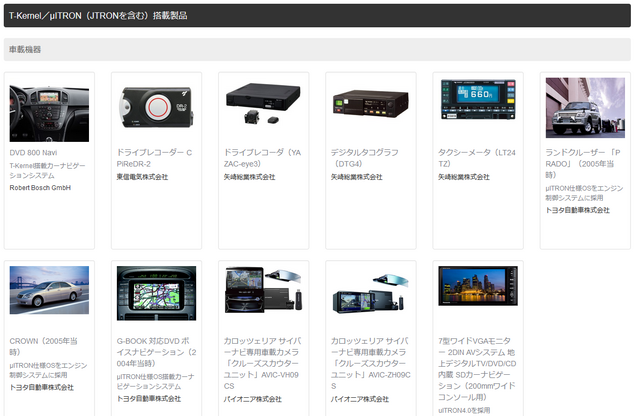
A4-2. The following is a list of typical applications quoted from page 8 of [19].
All products in the following slide use ITRON specification OS except for Suzuki Exceed and Nissan Skyline automobiles.The cars use RTOS based on OSEK specification, and not ITRON specification RTOS. The TOPPERS project [19] has developed automobile RTOSs based on OSEK specification and AUTOSAR specification using the expertise gained from the research and development of ITRON specification OS. Two automobiles are listed from this viewpoint.
[A5] The world atlas that shows the regions/countries where TRON RTOS family has been downloaded by some parties there.
Taken from the 2019 TRON Symposium (TRONSHOW) guidebook distributed at the venue. The map was created based on the download data as of 2019, the last year in which face-to-face TRON Symposium (TRONSHOW) was held. In 2020 and 2021, the guidebook distribution stopped due to COVID-19.
[A6] Figure-6 of T. N. B. Anh and S. -L. Tan, "Real-Time Operating Systems for Small Microcontrollers," in IEEE Micro, vol. 29, no. 5, pp. 30-45, Sept.-Oct. 2009
Dedication Ceremony
Map













